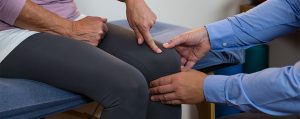Why New Moms Need Physical Therapy
The wait is finally over; after nine months of doctor appointments and nursery decorating, your baby has arrived! Keep in mind, that it’s still an ongoing process after giving birth, and along the journey of pregnancy, your body has encountered many changes. You may find it difficult to return to your prior activity levels or experience new problems related to your pelvic floor. This blog will discuss how new moms can benefit from physical therapy to address any concerns after having their baby.
Physical Therapy for Every Stage of Pregnancy
Pregnancy, labor and delivery, recovery and motherhood are athletic events in themselves! And while women are extremely resilient, many may find great benefits through physical therapy. Physical Therapists who specialize in Pelvic Health can assist your journey at every stage of pregnancy, as well as in the recovery stage throughout the fourth trimester.
Returning to Exercise Postpartum
After giving birth, a lot of questions arise on how to return to a workout program safely once cleared by your doctor. Every birth is different (vaginal delivery vs caesarian section), so it’s important to discuss with your doctor before returning to exercise. Typically, walking and gentle exercises are permitted immediately after birth, but most doctors do not clear women for impact activities until at least 6 weeks postpartum. Certain women’s recoveries will be longer, and it is important to ease into abdominal strengthening. Starting a vigorous workout too early can cause problems such as incontinence or prolapse of the pelvic floor (when organs in the pelvis slip down from their normal position).
Four Things to Know about Tummy Time
There is so much for new parents to know, including concerns as parents bring home their new baby. A huge need for babies is tummy time. As a physical therapist, I recommend to my parent patients that they should attempt to perform a few minutes of tummy time every awake period. This allows for the baby to avoid constantly laying on their back after and right before a nap. Below are four things you should know about tummy time:
The Fourth Trimester: The Birth of a Mother
In the weeks following the birth of a baby, a new mother emerges. The fourth trimester used to be defined as the first six weeks postpartum. This period was also known as a singular event, only being addressed at the six-week checkup. The visit would consist of a depression screening, evaluation of the cervix, uterus, cesarean birth scar/episiotomy scar, family planning/birth control and discussion of breast/bottle feeding. In recent years this has changed – and for good reason.
Bring Closure to Diastasis Recti
(Are we ever, ever, ever… getting back together?)
Diastasis recti…sounds like an odd sea creature, doesn’t it? If you are a pregnant mom, or have recently delivered, you may be familiar with the term.
Carpal Tunnel in Pregnancy
Thick hair and nails, radiant skin, and…hand numbness? The later weeks of pregnancy bring some welcomed physical changes that others may notice and comment how a woman has “a pregnancy glow.” But in a portion of women, the third trimester may also bring the uncomfortable symptoms of carpal tunnel syndrome.
Physical Therapy for Endometriosis
Endometriosis occurs in women when endometrial tissue forms on the outside, instead of the inside, of the uterus. Normally, the endometrial tissue is shed during menstruation and exits the body. With endometriosis, the tissue that has grown outside of the uterus and is located in the pelvic and abdominal areas bleeds during menstruation but is unable to be discharged from the body. This leads to irritation and inflammation in this area. Over time, the repeated bleeding and healing can lead to development of scar tissue and adhesions in the area which will result in pelvic pain. (more…)

